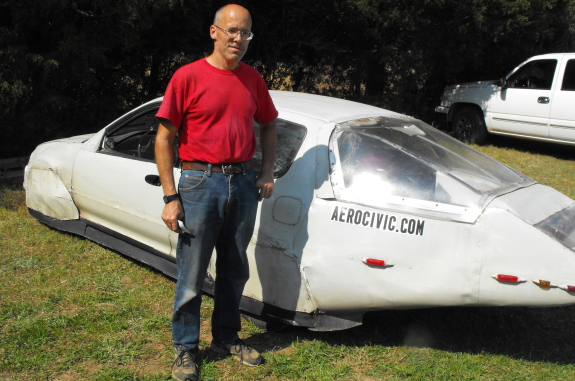
Home grown aero modification update

I first blogged about Mike
Turner towards the end of
July of last year.
Imagine my surprise when I saw him and his AeroCivic at a farmers
market down in South Carolina this past Friday.
Turns out he's got some new
ambitions on adding an electric 5th wheel
to push the car under certain road conditions. At the moment it's not
economically feasible due to the high cost of good batteries, but it
might not be too long before some clever engineer comes up with
a better and cheaper battery that perhaps is somewhat environmentally
responsible to produce.
If you'd like to learn more
about Mike check back in tomorrow to see a short video interview I did
with him where he describes what happened when he hit a deer with the
AeroCivic and how it just dented the hood and flipped over the top.
He's also got an excellent
website which has a
generous supply of construction images while the
AeroCivic was being born.
Want more in-depth information? Browse through our books.
Or explore more posts by date or by subject.
About us: Anna Hess and Mark Hamilton spent over a decade living self-sufficiently in the mountains of Virginia before moving north to start over from scratch in the foothills of Ohio. They've experimented with permaculture, no-till gardening, trailersteading, home-based microbusinesses and much more, writing about their adventures in both blogs and books.
Want to be notified when new comments are posted on this page? Click on the RSS button after you add a comment to subscribe to the comment feed, or simply check the box beside "email replies to me" while writing your comment.

Mike Turner estimates that his 400 dollar investment in this aero modification has saved him over 2500 bucks in added fuel costs compared to the Civic before he altered it.
http://ecomodder.com/ is another good place to learn about other do it yourself aero modifications and the people who modify them.
I'm surprised the big 18 wheeler cabs don't utilize some form of this design.
In 1933, Richard Buckminster Fuller unveiled the Dymaxion car, which was wind-tunnel optimized.
And while the idea is sound, it looks really slapdash and ugly. There are moldless composite construction techniques that would look much better.
The point I was trying to make is that efficient doesn't need to be ugly. And it is even better when it isn't! And it is not that hard either.
And it is even better when it isn't! And it is not that hard either.
If you look at aircraft (which need to have very good aerodynamics to keep drag and therefore power requirements down), the outside will be as smooth as manufacturing technology allows. A smooth shape has less drag then a rough one. It is one of the reasons why e.g. sailplanes and small aircraft are largely built in composites these days, and why even large manufacturers like Boeing and Airbus are turning to these materials. It is relatively easy to to make smooth and curved surfaces in composites, and they are relatively light for their strength and stiffness.
It has been known since the 1930s that a droplet shape has the lowest Cd. The aforementioned dymaxion car reached Cd=0.25 in 1933, which to my knowledge remains unbeaten by production cars to this day! The solar-powered nuna reaches Cd=0.07! But you wouldn't want to drive that on a busy road.
The problem with these highly aerodynamic shapes is that they are not optimal with regard to e.g. safety and ease of production. A droplet shape would put the passengers up front, which mostly precludes the use of a crumple-zone up front. And while we can build extremely aerodynamic planes, the techniques and materials used are expensive and not a good fit for the car industry.
Based on my experience in composites I think it would be possible to make a very aerodynamic car out of composites weighing around half of an equivalent metal car, with an equivalent reduction in rolling resistance, material use and engine size. But generally the manufacturing techniques used would be much more expensive than those of current cars, although some are claiming inprovements.
It's not that difficult to make a flowing and pleasing shape, even single pieces.
Builders of wooden boats have been doing that for centuries. For something less elaborate you can use the stich-and-glue technique with plywood, but this does limit your design freedom somewhat; there are limits to how much you can bend plywood.
(A nice example of top-notch wooden sandwich construction is the restauration of a De Haviland Mosquito now being undertaken in New Zealand. The wooden fuselage and wing of this plane is being built anew with the same techniques used 70 years ago! With its light-weight construction and excellent streamlining the Mosquito was the fastest piston-engined plane around for a large part of WWII. I'm very impressed with the workmanship and dedication of the team building this.)
A technique related to the one used for wooden boats but with modern composite materials is the foam sandwich construction. You'd have to be(come) familiar with working fiberglass and polyester resin, though.
Of course if you want to make more than one piece, it's usually more efficient to make a mold and fabricate the product inside that.